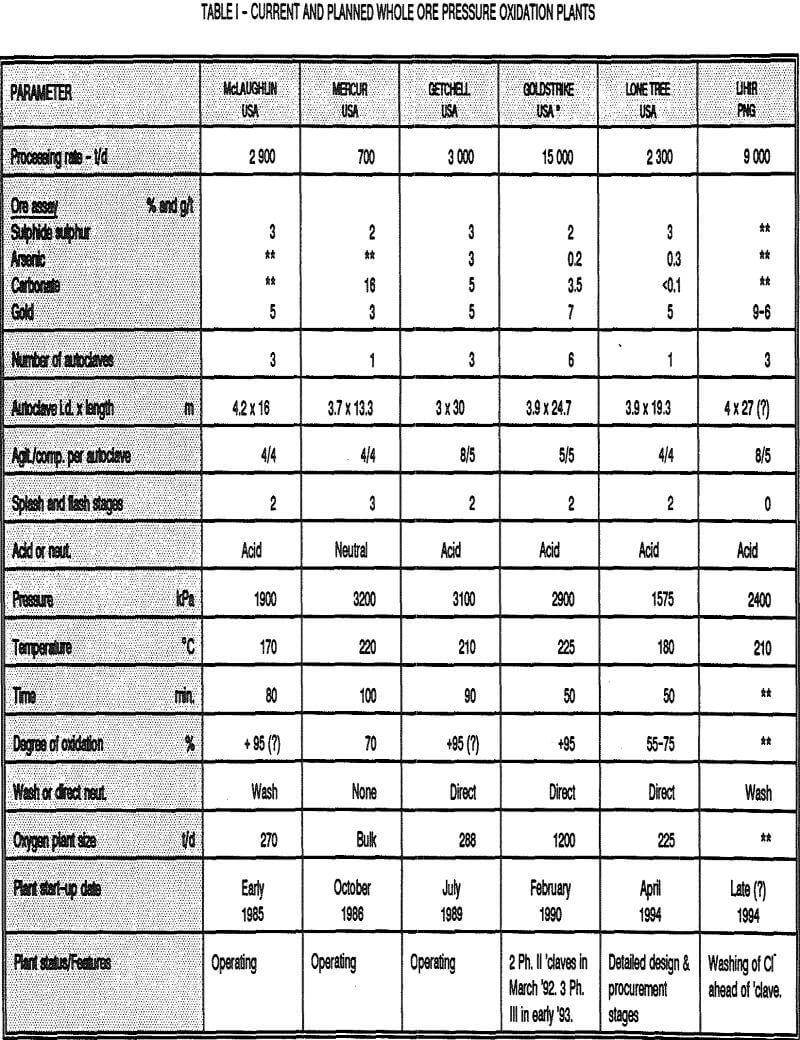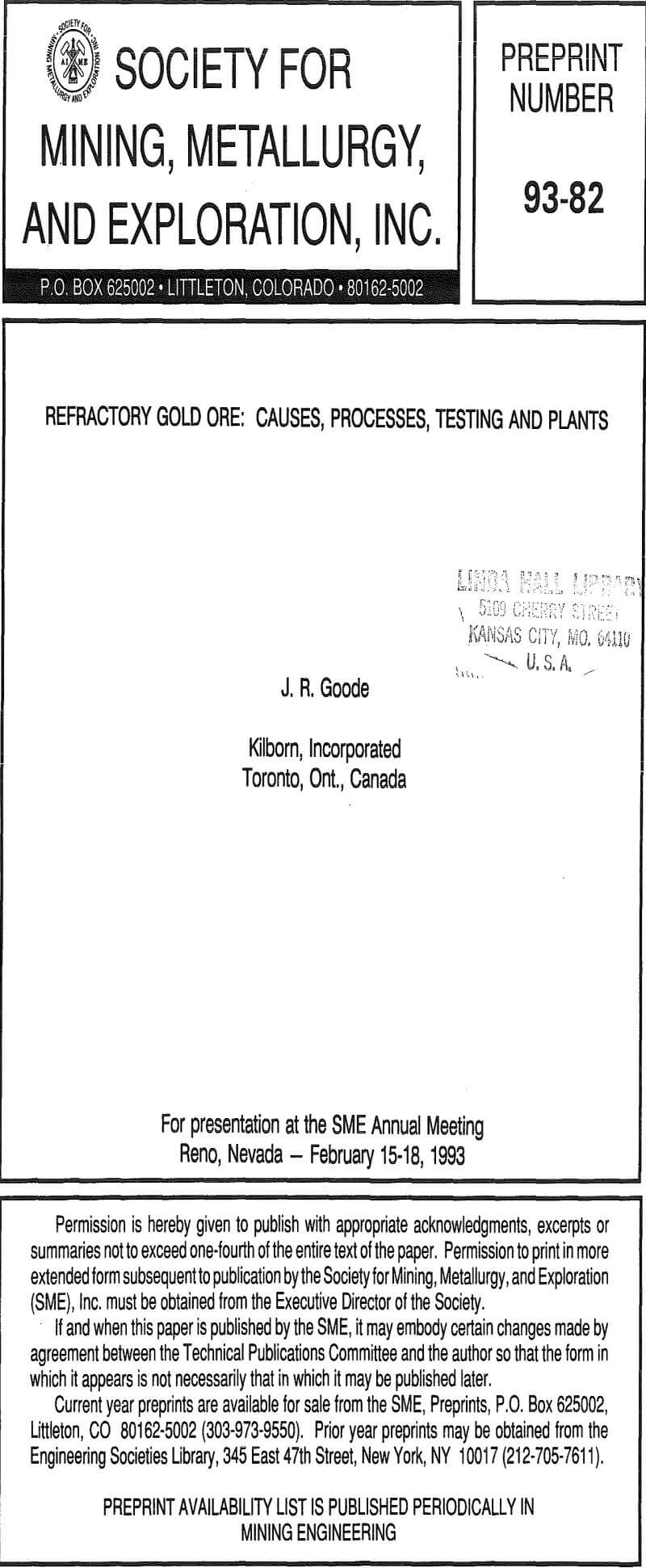Table of Contents
Gold in primary deposits is generally recovered by dissolution in dilute cyanide solution followed by recovery from solution using zinc cementation or carbon adsorption. The dissolution step can be conducted in heaps, vats, or agitated tanks. Gravity concentration, or an intermediate flotation step is an additional process at some operations. An analysis of the processing methods used for primary gold recovery in 1989 indicated that more than 94% of a total of 1677 t (54 million ounces) of gold were recovered by these simple techniques.
Refractory Ore Types
To be effective, cyanide solution must contact and dissolve the majority of the gold particles in the ore. In one type of refractory ore, the leach solution never comes into contact with a portion of the gold because it is present as fine particles encapsulated within impermeable ore particles. Obviously this is a particle size related effect and fine grinding can sometimes improve recovery.
Some ores contain “invisible gold” that is either present as extremely fine particles (less than 5 µm) or is actually incorporated into the structure of minerals such as arsenopyrite. Very fine grinding usually has limited effect on this type of refractory ore.
Other refractory ores contain naturally occurring active carbon. The gold may be adequately exposed to the leach solution and dissolution proceeds to completion but adsorption of the gold onto the carbon leads to low recovery to solution. This phenomenon, generally known as “preg-robbing”, is particularly common in Nevada. The carbon can be passivated or destroyed by chlorine, pressure oxidation, or roasting.
Refractory Ore Pretreatment Processes
A “fine” grind in a gold production plant might produce a particle size distribution in which 80% of the ore is finer than 44 µm. Ultra-fine grinding can be defined as a process that produces an 80% passing size of 20 µm or less. Depending on the size distribution of gold particles, ultra-fine grinding can be sufficient to improve leach recovery significantly. Ultra-fine grinding also can be used as a preliminary step ahead of one of the other pretreatment processes.
Pressure oxidation is one of several pretreatment processes that work by chemically destroying the gold encapsulating minerals and/or deactivating deleterious components of the ore. Several papers describe the chemistry of the process and its development. In a typical plant, ore or concentrate is continuously processed through an autoclave at a temperature of about 200°C (400°F), and an oxygen overpressure of 500 kPa (75 psi). Residence time is commonly in the range of 45 to 200 minutes.
Autoclave discharge contains excess sulphuric acid and iron sulphates in solution. If acid recycle is practised, as at McLaughlin, these species are recycled to the acidification circuit ahead of the autoclave where they are neutralized by incoming carbonates. In other plants, such as Goldstrike, limestone and/or lime is used to neutralize these species before sending the oxidized ore to cyanide leaching.
Bacterial oxidation has been at work for many centuries and has very efficiently converted millions of tons of refractory ore to a readily cyanided form. The oxide caps overlying the refractory ores of Nevada, Western Australia, and elsewhere have all been created by bacterial action.
The bacteria that are used in commercial scale bio-oxidation plants are predominately an acclimatized strain of thiobacillus ferro-oxidans. Other bacteria have been isolated, tested, and proposed including a “moderately thermophilic” culture. High temperature and salinity tolerance is claimed for these bacteria. A few years ago, the claimed temperature tolerance might have been an advantage but the current strain of thiobacillus ferro-oxidans appears to have been acclimatized to similarly elevated temperatures.
Chlorination is an important pretreatment process for preg-robbing ores and ore containing chlorine-amenable, framboidal (or spheroidal) sulphides. The process is presently in use at Independence Mining’s Jerritt Canyon operation on ore 76 and as a heap leach pre-treatment process. Chlorination was first used at Newmont’ s Carlin mill in 1971 to treat 500 t/d of refractory ore.
Ranking studies
The initial study should examine all reasonable options. Capital and operating costs can be based on very preliminary flowsheets and general arrangement drawings. Cost estimates at the ± 25% level of accuracy would be more than sufficient. The study should highlight cost sensitivities and steer laboratory work away from unproductive routes. The cost of such an analysis by an experienced engineering company would probably be in the $10,000 to $20,000 range.
Process Selection Process
Refractory gold ore processing offers unique challenges to the metallurgist. There is a temptation to pursue higher gold recovery regardless of overall economics. The most important tool in the selection process is therefore the discounted cash flow (DCF) analysis of the project options. The DCF is the only way to properly reconcile different capital costs, operating costs, gold recoveries, development schedules, and technical risks.


